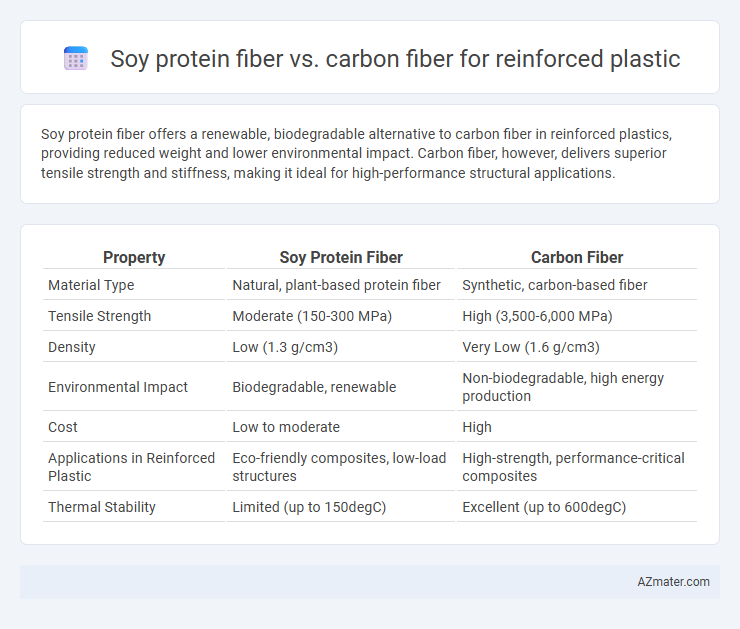Soy protein fiber offers a renewable, biodegradable alternative to carbon fiber in reinforced plastics, providing reduced weight and lower environmental impact. Carbon fiber, however, delivers superior tensile strength and stiffness, making it ideal for high-performance structural applications.
Table of Comparison
| Property | Soy Protein Fiber | Carbon Fiber |
|---|---|---|
| Material Type | Natural, plant-based protein fiber | Synthetic, carbon-based fiber |
| Tensile Strength | Moderate (150-300 MPa) | High (3,500-6,000 MPa) |
| Density | Low (1.3 g/cm3) | Very Low (1.6 g/cm3) |
| Environmental Impact | Biodegradable, renewable | Non-biodegradable, high energy production |
| Cost | Low to moderate | High |
| Applications in Reinforced Plastic | Eco-friendly composites, low-load structures | High-strength, performance-critical composites |
| Thermal Stability | Limited (up to 150degC) | Excellent (up to 600degC) |
Introduction: The Rise of Reinforced Plastics
Soy protein fiber offers a sustainable alternative to traditional carbon fiber in reinforced plastics, promoting eco-friendly manufacturing and biodegradability. Carbon fiber remains preferred for high-strength, lightweight applications due to its superior tensile strength and stiffness. Innovations in soy protein fiber composites are closing the performance gap by enhancing mechanical properties while significantly reducing environmental impact.
Overview of Soy Protein Fiber
Soy protein fiber, derived from soybeans, offers a sustainable and biodegradable alternative to traditional reinforcements in plastic composites. It exhibits good tensile strength and thermal stability, making it suitable for lightweight applications in automotive and packaging industries. Compared to carbon fiber, soy protein fiber provides cost-effective reinforcement with lower environmental impact but typically has lower mechanical strength and durability.
Overview of Carbon Fiber
Carbon fiber consists of thin, strong crystalline filaments of carbon, widely used in reinforced plastics due to its exceptional strength-to-weight ratio and high stiffness. Its molecular structure provides superior tensile strength and resistance to chemical and environmental degradation, making it ideal for aerospace, automotive, and sporting goods applications. Compared to other fibers like soy protein fiber, carbon fiber delivers unmatched mechanical performance and durability under extreme conditions.
Mechanical Strength Comparison
Soy protein fiber exhibits tensile strength values typically ranging from 300 to 600 MPa, making it a sustainable yet moderately strong reinforcement option for plastics. In contrast, carbon fiber provides exceptional mechanical strength with tensile strength exceeding 3,500 MPa, significantly enhancing stiffness and impact resistance in reinforced plastics. The disparity in performance emphasizes carbon fiber's superiority for high-strength applications, while soy protein fiber offers environmental benefits and adequate strength for less demanding uses.
Weight and Density Differences
Soy protein fiber reinforced plastics exhibit a significantly lower density, typically around 1.2-1.3 g/cm3, compared to carbon fiber composites which have a density near 1.6 g/cm3. This lower density translates to lighter weight materials, making soy protein fibers advantageous in applications where weight reduction is critical. However, carbon fiber reinforced plastics offer superior strength-to-weight ratios despite their higher density, balancing performance and weight in high-stress applications.
Thermal and Chemical Resistance
Soy protein fiber exhibits moderate thermal resistance with degradation temperatures around 230degC, making it less suitable for high-temperature applications compared to carbon fiber, which maintains structural integrity above 600degC. Chemically, soy protein fiber is prone to degradation when exposed to harsh solvents and acidic environments, whereas carbon fiber demonstrates superior chemical resistance, resisting corrosion and chemical attack in most industrial settings. These characteristics make carbon fiber the preferred choice for reinforced plastics requiring high thermal and chemical stability.
Cost Analysis: Production and Materials
Soy protein fiber offers a cost-effective alternative to carbon fiber in reinforced plastic production, with raw material expenses significantly lower due to the abundance and renewability of soybeans. Production costs for soy protein fiber composites are reduced by simpler processing techniques and lower energy requirements compared to the energy-intensive manufacturing of carbon fiber. However, while soy protein fiber provides economic advantages in materials and production, its mechanical properties and durability might necessitate additional treatments, potentially influencing overall cost-efficiency in high-performance applications.
Environmental Impact and Sustainability
Soy protein fiber offers a renewable and biodegradable alternative to carbon fiber in reinforced plastics, significantly reducing environmental impact by lowering carbon emissions and waste during production. While carbon fiber provides superior strength and durability, its energy-intensive manufacturing and non-biodegradable nature contribute to long-term environmental challenges. Incorporating soy protein fiber enhances sustainability by promoting circular economy principles and reducing reliance on fossil-fuel-based materials.
Application Suitability in Industries
Soy protein fiber offers eco-friendly reinforcement for plastics in packaging, automotive interiors, and consumer goods due to its biodegradability and lower cost, supporting sustainability goals. Carbon fiber excels in aerospace, automotive, and sports equipment industries where superior strength-to-weight ratio, stiffness, and durability are crucial for high-performance structural applications. The suitability depends on balancing environmental impact, mechanical requirements, and budget constraints within specific industry use cases.
Future Trends and Research Directions
Soy protein fiber offers a sustainable, biodegradable alternative to carbon fiber for reinforced plastics, driving research toward enhancing its mechanical strength and durability. Future trends emphasize hybrid composites combining soy protein fibers with traditional materials to achieve improved performance and reduced environmental impact. Ongoing studies explore nano-reinforcements and bio-based resin compatibility to expand industrial applications and promote circular economy principles.

Infographic: Soy protein fiber vs Carbon fiber for Reinforced plastic
 azmater.com
azmater.com